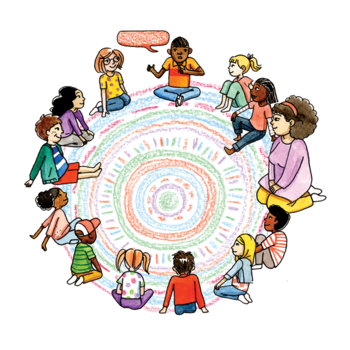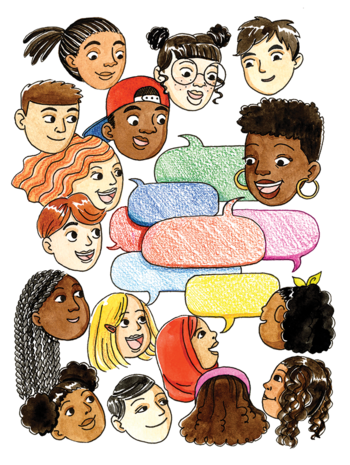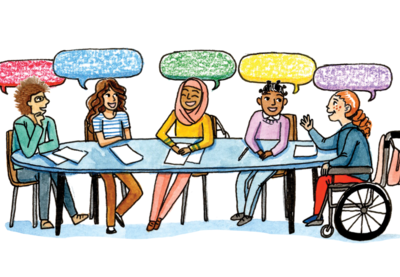In the Fall 1992 issue of Teaching Tolerance magazine, we published the feature story “Talk About It!”
Earlier that year, the Rodney King verdict and the ensuing L.A. riots made it clear that “we didn’t know what to say to each other,” we wrote in that second-ever issue. Educators, we said at the time, faced a new and urgent need: “to find ways to talk truthfully about things like bigotry, injustice and violence.”
More than 25 years later, the need is just as great. That’s part of the reason we’re releasing a new edition of Let’s Talk!, our guide to leading critical conversations with students.
Released in 2015, the original Let’s Talk! recommended ways K–12 educators could prepare for classroom conversations about critical topics and address student discomfort as the conversations unfold.
For our newest edition, we collected feedback from readers and users of the original and solicited advice from our Teaching Tolerance Advisory Board. In response to their suggestions, we expanded the guide. The new version helps K–12 educators lay the groundwork for conversations (on their own and with students), and it outlines classroom-ready strategies educators can use with students before, during and after critical conversations.
We’re pleased to share this excerpt from Let’s Talk!, which offers four recommendations for beginning such a discussion with your students.
Opening the Conversation
1. Be positive.
Your students take their cues about how to approach the conversation from you. When you engage critical topics with confidence, respect, and a genuine curiosity about your students’ ideas and experiences, you encourage them to speak thoughtfully and truthfully and to value one another’s contributions.
2. Establish norms.

Begin the discussion with a collaboration; setting norms together helps students build ownership in the conversation. It may reassure students to know that the discussion will have a clear structure. It also demonstrates your respect for student identities by including them in the shaping of the discussion. And they will likely have ideas that you haven’t considered.
There are any number of ways you can work with students to establish norms, from whole-group brainstorming and small-group collaboration to journaling and sharing.
You could lead students through a “Sounds/Looks/Feels” model.
Ask students three questions:
What do we want our conversation to sound like?
Some norms will probably be obvious—no insults—but others should be more complex. Students may agree to limit their contributions until everyone’s been heard or ask that everyone begin by restating the idea they’re responding to.
A review of vocabulary can cut down on misunderstandings. Reminding students about people-first language, for example, or about the difference between sex and gender can help ensure that everyone has the language they need to communicate clearly.
Here are a few stems that students can use to question or disagree with classmates.
- “What did you mean when you mentioned … ?”
- “I agree and would add … ”
- “I agree when you say … but disagree when you say … ”
- “I disagree when you say … because …”
What do we want our conversation to look like?
These suggestions will likely address respect. Students could suggest that desks be arranged in a circle, that listeners turn to the speaker and that phones, devices and computers be put away.
This is a good time to remind students once again of the difference between intent and impact. You can also address tokenism at this time, reminding them that no individual can speak for an entire group and that we shouldn’t expect them to.
What do we want our conversation to feel like?
It may be more difficult for students to generate responses to this question, but answers could include that students expect to feel respected and believed.
If you’ve laid the groundwork for productive critical conversations, your students should have confidence that their identities and experiences will be valued. Remember that feeling safe and valued is not the same as feeling comfortable. Address this directly: Your discussion may at times be uncomfortable, but discomfort is a necessary part of growth. ...
Find the full version of Let’s Talk! Facilitating Critical Conversations With Students here.
3. Establish goals.
Students should know why a critical conversation is taking place and what you expect them to gain from it. Talking through goals with your students also eases the class into the discussion. If you generally begin with an essential or compelling question, try involving students in its development. This offers an easy way to connect a critical discussion to the lesson, event or news that sparked it.
4. Offer a shared starting point.
However a critical topic finds its way to your classroom, remember that connections that seem obvious to you may not be clear to students. Instead of requiring them to be ready to jump into a critical conversation, provide a prompt to connect the discussion to their lives and to the curriculum.
Text-response prompts
Text-based prompts give students an opportunity to begin discussing a critical topic without immediately requiring that they share their own experiences. Choose a text—an image, a video, a song or a piece of writing—to share with students. Begin by letting them study the text, offering time for reflection or freewriting. Then ask students to respond.
Try asking these kinds of questions:
- Describe the text. What is happening? Who is taking action? What are they doing?
- Who in this text has power? How can you tell?
- Is there unfairness or injustice? How can you tell?
- What assumptions, misinformation or biases might be used to justify this injustice?
- Who benefits from these assumptions, misinformation or biases? Who suffers from them?
- What about this text do you think will surprise most readers (viewers, listeners)? Did it surprise you? Why?
- What would justice or fairness look like in this text? How can you relate this text to a critical topic like gender bias, ableism, anti-immigrant sentiment, religious bias or anti-LGBTQ persecution?
- How can you relate this text to your own experience or community?
Personal-response prompts

Personal prompts, which open a discussion with questions, are particularly effective ways to build student interest in a critical topic. You might have students respond anonymously and then review their answers prior to the discussion. Or you could ask them to write as a way to start thinking through a topic before they’ll be asked to share. One thing to keep in mind is that students with dominant cultural identities may struggle to articulate the ways that their identities have shaped their experience—this may be one of the few times they’ve ever been asked to do so. Consider including questions about multiple identities, providing model responses or simply reordering the questions below to ensure that all students are engaging with the critical discussion from the beginning.
Here are a few questions to try with secondary students:
- What are your earliest memories of race?
- What messages did you hear about your own race as you were growing up? What messages did you hear about other races? Where did these messages come from?
- How often have you thought about your race in the last 24 hours? In the last week?
- How does your race factor into the way you make everyday decisions? What about important life decisions? ...
- If you could change one thing about our school that’s related to race, what would you recommend? How would you implement it?
- How would you compare the attitudes about race you see on our campus to those you see in our town? In our state? In our nation?
These questions are adapted from materials by the Office of Student Diversity, Engagement and Success at the University of Wisconsin-Whitewater.
And here are some questions for elementary students:
- How are the students in our school diverse?
- Do you have a friend who is a different race than you?
- When you look at your cafeteria, do students group themselves in a certain way? Why do you think that happens?
- Think about the characters in your favorite movie, TV show or book. How are the characters like you? Different from you? Would you say the characters are diverse?
For very young students, consider having them mark a piece of paper with plus or minus signs to indicate their level of comfort or familiarity with a topic. For example, if your critical discussion has been prompted by a current event, you might ask students if they’ve heard about what happened, with “+” for yes and “–” for no. This will help you determine the level of background you’ll need to provide.
A quick word of caution:
Although you are encouraging students to speak about their feelings, don’t require them to share anything too personal. It isn’t fair, for example, to require students to share about a time when they were the victims of discrimination and make them revisit that experience during class. Instead, try a sentence stem like, “One word that comes to mind when I hear the word ‘immigration’ is …” or “One word to describe how I feel talking about race is …”
